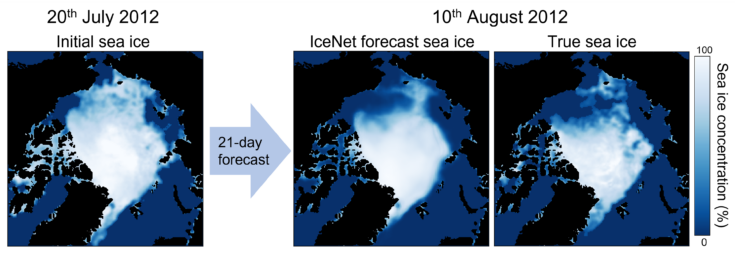The start of November sees governments, leading AI companies and experts gather at Bletchley Park for the first AI Safety Summit, aiming to mitigate the risks of AI as a transformative technology.
In this edition of Beyond the Ice, we’ve gathered our own panel of experts from the British Antarctic Survey AI Lab and The Alan Turing Institute to explain how AI is being used for good in the Arctic.
 |
Dr Ellie Bowler, Machine Learning Research Scientist at BAS Ellie’s research uses machine learning to monitor, detect and predict risks to wildlife. She develops image algorithms to count wildlife in very high resolution satellite imagery, as part of the Wildlife from Space research group. |
|
 |
Dr Alden Conner, Senior Researcher at The Alan Turing Institute Alden is a neurobiologist who now works with interdisciplinary teams to integrate the use of AI in scientific discovery. |
|
 |
Tom Andersson, Machine Learning Research Scientist at BAS Tom’s machine learning research uses large datasets from climate models, satellites, and stations to develop tools for monitoring and adapting to climate change. He specialises in the use of neural processes in environmental sciences. |
|
 |
James Byrne, Research Software Engineer Lead at BAS James’s work focuses on development of digital research infrastructure supporting environmental data science. He helps researchers develop sustainable software and services that promote adoption by collaborators and end users. |
The Arctic, a region characterised by its extreme cold, vast icy landscapes, and unique ecosystems, is facing significant challenges due to rapid climate change and increasing human activity. While these challenges pose threats to the delicate balance of the Arctic environment, advancements in artificial intelligence (AI) have emerged as a powerful tool to monitor, predict, and mitigate these challenges.
From sea ice prediction to wildlife conservation, AI is making a positive impact in the Arctic, offering hope for a more sustainable and resilient future for this critical ecosystem.
Sea Ice Prediction
Every week, billions of people worldwide rely on meteorological forecasts to make choices – ranging from what clothes to wear, to deciding whether to flee a hurricane. In the Arctic, people and wildlife must contend with changing sea ice conditions as well as extreme weather. The frozen Arctic oceans act as a vital platform for hunting, travel, and cultural activities for coastal Indigenous peoples, and play a critical role in maintaining Arctic food webs. Declining sea ice levels due to global warming have already had devastating impacts which will only increase as warming progresses, and the thinner ice pack is more weather driven and tougher to predict.
The Arctic has an urgent need for accurate forecasts of sea ice to supplement weather forecasts. However, the complexity of sea ice has proved a stumbling block for traditional physics-based numerical models, limiting their ability to provide meaningful decision support for Arctic communities.
Together at British Antarctic Survey and The Alan Turing Institute, we are collaborating on IceNet, a cutting edge project aiming to address the impact of climate change on the Arctic using an AI sea ice forecasting system. The IceNet AI uses satellite data and weather observations to forecast pan-Arctic 25km2 sea ice concentration on a daily timescale up to several months ahead, which can allow Arctic residents to prepare and adapt to changing conditions.

The system uses advanced AI techniques that mine decades of observations, supplemented by the intelligent fusion of centuries of past and future climate simulations, to learn how sea ice evolves over time. This approach has proved remarkably effective: an earlier version of IceNet outperformed the leading physics-based system in notoriously difficult seasonal summer forecasts; these findings were published in Nature Communications in 2021.
Wildlife Conservation
One of the significant areas where AI is making a difference in the Arctic is wildlife conservation and protection. With the help of cutting-edge sensors and advanced AI technologies , researchers and conservationists are now able to monitor and track the movement of Arctic species such as polar bears, Arctic foxes, and marine mammals. AI is now routinely applied to camera and satellite imagery to automate information extraction in order to aid research on animal behaviour, ocean health, population dynamics, and habitat changes, enabling scientists to develop effective conservation strategies and policies to protect species at risk from the impacts of climate change and human activities.

The IceNet team is now turning their research into action in several ways. Research software engineers at BAS and Turing have developed a powerful digital infrastructure for IceNet, allowing the system to be trained faster, run in real-time, and offer a host of possibilities for useful applications, such as operation planning, analysis of environmental events, and environmentally responsible maritime navigation.
The IceNet team is collaborating with the Government of Nunavut (GN) and the World Wide Fund for Nature (WWF) to explore the use of IceNet as an early warning system for Arctic conservation. This has led to a proof-of-concept ‘conservation early warning and alert system’ for Dolphin and Union Caribou migrations (video below), a species considered endangered by the Committee on the Status of Endangered Wildlife in Canada.
March 2023 saw IceNet’s first real-time application, where its forecasts around Lancaster Sound in Canada were used to aid a large-scale polar bear survey, which the GN biologist lead described as “incredibly informative”. The actions of the team prove their commitment to using their expertise to empower the North with cutting-edge technology for mitigating climate change impacts.
Integrating Indigenous Knowledge
In 2021, PolArctic successfully completed a pioneering project in Sanikiluaq, Nunavut, Canada, combining Indigenous Knowledge with cutting-edge AI, scientific research, and satellite data.
By integrating traditional Inuit knowledge, scientific data, and remote sensing techniques, the project identified untapped fishing locations, mitigating the impact of changing climate patterns on fish availability. This pioneering initiative, funded by the Nunavut Fishery Association, Qikiqtaaluk Corporation, and WWF, laid the groundwork for sustainable and adaptable mariculture solutions in the Arctic.
The project showcased the significance of merging Indigenous and western knowledge systems, overcoming data limitations posed by the Arctic’s unique environmental conditions. Leveraging the Nunavut Coastal Resource Inventory (NCRI) and various satellite sources, PolArctic’s AI model facilitated informed decision-making for the local mariculture industry, offering insights into habitat changes and growth conditions. By providing vital information in both Inuktitut and English, the AI not only supported research planning and economic exploration but also informed infrastructure development, paving the way for economic growth and job opportunities within the community.
Looking ahead, the initiative’s success points to the possibility of replicating this collaborative approach across the Arctic, emphasising the transformative potential of integrating human and technological intelligence to address pressing environmental challenges.
Search and Rescue Operations
The harsh and unpredictable conditions in the Arctic pose significant challenges for search and rescue operations. AI-ARC – a consortium of 22 partners, including the UK Maritime and Coastguard Agency – is developing an AI based virtual control room for the Arctic, which will enhance the efficiency and effectiveness of search and rescue missions in the Arctic.
AI and drone technology is also being used for search and rescue in Canada. By analysing real-time data on weather conditions, ice movements, and geographical terrains, AI algorithms can assist in identifying optimal routes and locations for rescue operations, thus saving valuable time and resources and increasing the chances of successful rescues in this challenging environment.
Where next for IceNet?
We have ambitious plans to expand IceNet’s forecasting capabilities. For example, the current 25 km2 spatial forecast scale isn’t high enough resolution many real-world applications. By leveraging more recent, higher resolution passive microwave and radar-based satellite data, the team are planning to use AI ‘transfer learning’ to increase spatial resolution by a factor of four or greater. This would provide substantially more value to forecast users.
Alongside improved accuracy and resolution of the AI system, the project team are working to improve user interfaces for conservation workers, robustness of early warning systems, and the real-time and historical forecast analysis tools. The IceNet infrastructure is now being expanded to provide increased levels of interoperability providing better integration possibilities for downstream services and users.
Sea ice conditions dictate the accessibility and safety of shipping, a key mode of transport for Arctic activity. BAS is developing an automated route planning platform to minimise vessel’s carbon impact in ice-covered polar oceans by avoiding ice breaking. Accurate sea ice forecasts will be critical for automated routing and decision support for maritime activity and conservation in polar waters. The IceNet team is keen to ensure the AI technology is used as a force for good, supporting maritime, scientific and conservation uses.
As we move towards the 5th International Polar Year in 2032-33 – and a once in a generation focus on new international polar research – there is clear potential for the considered use of AI and machine learning to take a major new role. To scale up the reach and impact of research, as well as acting as a bridge between traditional research from scientists and Indigenous people’s ways of knowing.
The application of AI in the Arctic is fostering innovative solutions that address critical environmental, social, and economic challenges. By combining technological advancements with scientific research and community engagement, AI is playing a crucial role in protecting the fragile Arctic ecosystem and supporting sustainable development in the region. As we continue to harness the rapidly developing power of AI, it is imperative to ensure that these technologies are deployed in a responsible and ethical manner, prioritising the long-term well-being of the Arctic and its inhabitants. In showing that AI can be used for good, we can work towards a more sustainable and resilient future for the Arctic and the planet.